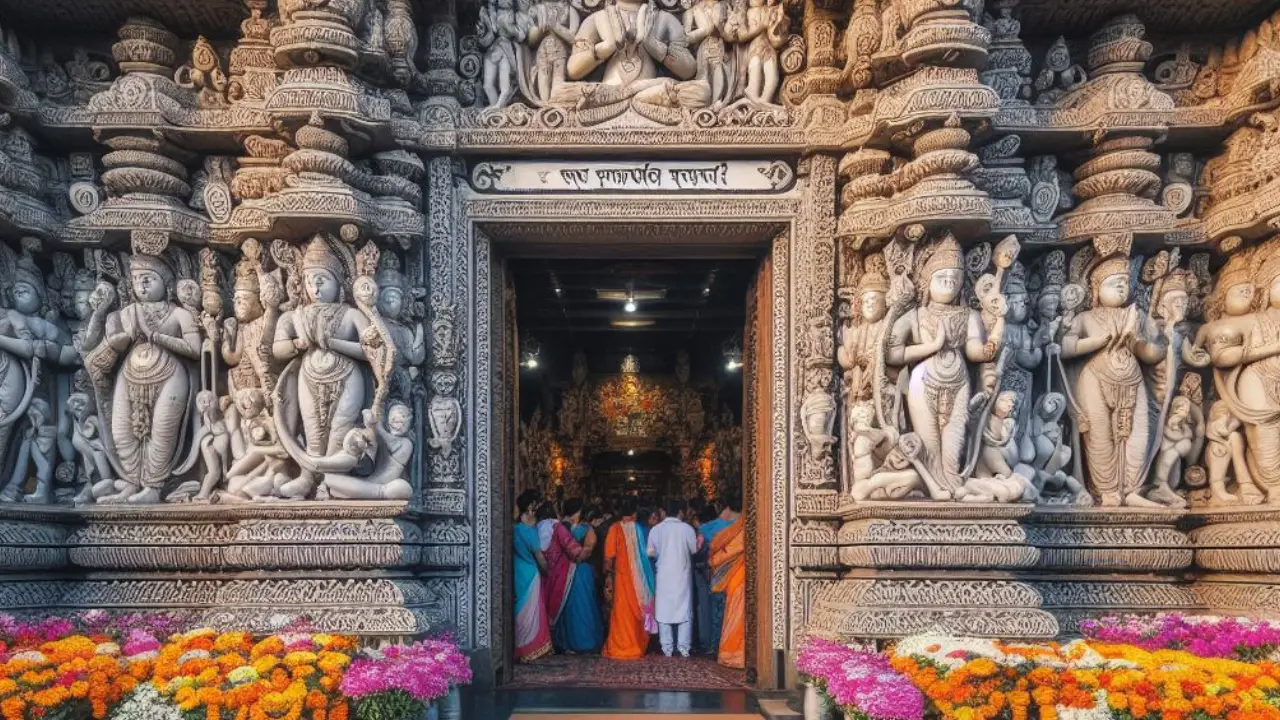In the serene landscape of Maharashtra, India, lies a beacon of spirituality – the Ballaleshwar Ganpati Temple. Located in the village of Pali, this temple isn’t just a structure of worship but a journey into the depths of devotion and culture. As one of the esteemed Ashtavinayak temples, it holds a revered spot in the hearts of Lord Ganesh’s devotees. In this blog post, we will explore the fascinating history, architectural marvels, and spiritual significance of this ancient temple that continues to inspire faith and devotion.
Historical Background
The Ballaleshwar Temple, dedicated to Lord Ganesha, finds its roots in ancient mythology. According to the legends, it is believed to be the place where Lord Ganesha appeared before his ardent devotee, Ballal, in the form of a young boy. Ballal, overwhelmed with devotion, built a temple in honor of the deity, thus giving birth to the Ballaleshwar Temple.
In 1640, craftsmen built the original wooden temple, which Ballal still worships as Lord Ganesha. In 1760, they renovated the temple to create space for a new stone structure shaped like the letter Shri.
Legend of Ballal’s Devotion
One of the most enchanting legends associated with the Ballaleshwar Temple revolves around the divine bond between Ballal and Lord Ganesha. It is believed that Ballal, despite facing numerous hardships, remained devoted to Ganesha. In a unique demonstration of his dedication, Ballal worshipped Ganesha as his spiritual guru.
The legend narrates that Ballal once offered food to Lord Ganesha but faced severe criticism from the community. Unperturbed by societal judgments, Ballal continued his devotion. Pleased by Ballal’s unwavering faith, Lord Ganesha transformed into a human form, appearing before him as a guru. This divine intervention bestowed Ballal with spiritual enlightenment, leading to the temple’s construction.
Architectural Marvel
The deity of Ballaleshwar, carved from rare black stone, captures hearts. Its navel and eyes, embellished with diamonds, shine with an ethereal glow. Dressed as a Brahmin, this representation of Lord Ganesha is unique. The idol’s artistry is a testament to the unparalleled skills of ancient Indian craftsmen.
The architecture of the temple is a fascinating blend of ancient and modern styles. Constructed using black stone and adorned with intricate carvings, the temple exudes a sense of grandeur and spirituality. Its main sanctum, or ‘Garbhagriha’, houses the deity of Lord Ballaleshwar, uniquely positioned. The idol faces east, allowing the first rays of the sun to bathe the deity.
Intricate carvings and motifs depicting various Hindu legends adorn the outer walls of the temple. The entrance is marked by an intricately carved Gopuram (gateway) depicting scenes from Hindu mythology.
Upon entering the temple complex, visitors encounter the stunning Nagarkhana, a musical drum tower that adds a rhythmic touch to the spiritual atmosphere. The temple also features a spacious sabha mandap (assembly hall), adorned with ornate pillars and delicate sculptures, providing devotees with a serene space for prayers and gatherings.
Spiritual Significance
The Ballaleshwar Temple holds immense spiritual significance for devotees of Lord Ganesha. It is believed that offering prayers here can bestow blessings of wisdom, knowledge, and success. The temple attracts a large number of devotees, especially on auspicious occasions like Ganesh Chaturthi, the birth anniversary of Lord Ganesha. The atmosphere resonates with the chants of hymns and the fragrance of incense, creating a profound spiritual experience.
Devotees undertake a circumambulation (pradakshina) around the sanctum, seeking the divine grace of Lord Ganesha. It is also customary to offer coconuts, modaks (a sweet delicacy associated with Lord Ganesha), and floral garlands as a mark of devotion. The temple premises are adorned with vibrant decorations during festivals, further enhancing the aura of divinity.
Cultural Significance
Beyond its spiritual importance, the Ballaleshwar Temple also reflects the rich cultural heritage of Maharashtra. It stands as a symbol of devotion, unity, and religious harmony. The temple attracts visitors from different walks of life, fostering a sense of communal harmony and cultural exchange.
The Ballaleshwar Temple comes alive during religious festivals and celebrations, attracting devotees from far and wide. One of the most prominent festivals celebrated here is Ganesh Chaturthi, which commemorates the birth of Lord Ganesha. During this time, devotees adorn the idol of Lord Ganesha with opulent decorations, worshiping it with great fervor and devotion, creating a grand spectacle at the temple. Chants, hymns, and the rhythmic beats of traditional musical instruments fill the atmosphere.
Apart from Ganesh Chaturthi, other festivals like Navratri, Diwali, and Maha Shivaratri are also celebrated with great enthusiasm and splendor. These festivals offer a glimpse into the rich cultural heritage and traditions of Maharashtra, showcasing vibrant processions, folk dances, and devotional songs.
Memories of a Pilgrim
I recall my visit to the temple during the auspicious time of Ganesh Chaturthi when I was doing the Ashtavinayak Yatra. The temple, enveloped in verdant greenery, seemed otherworldly. The morning aarti, with its resonant bells and chants, offered a profound spiritual connection.
Conclusion
The Ballaleshwar Temple, with its historical significance, architectural grandeur, and spiritual ambiance, remains an epitome of faith and devotion. As a pilgrimage site and a tourist attraction, it offers a sanctuary for seekers of spiritual solace and cultural enrichment. The temple’s sacred atmosphere and captivating architecture continue to inspire devotees and visitors, reminding us of the deep-rooted traditions and cultural legacy of Maharashtra. A visit to the Ballaleshwar Temple is not just a religious experience but also an opportunity to witness the rich tapestry of spirituality and cultural heritage that this magnificent shrine represents.
Have you visited the Ballaleshwar Ganpati Temple or another Ashtavinayak site? Share your stories and reflections. Let’s build a community of shared spiritual journeys and cultural explorations.

